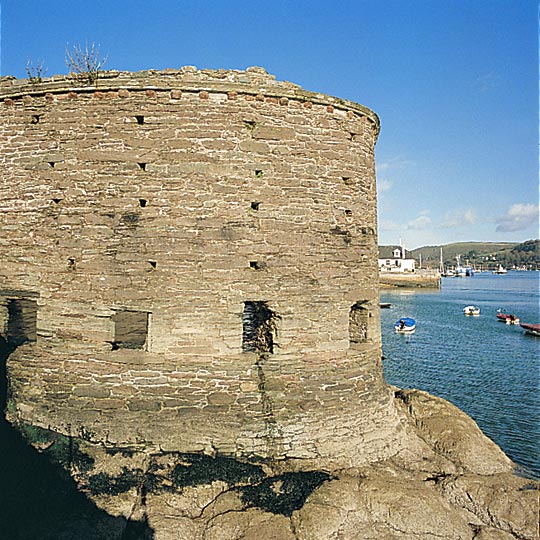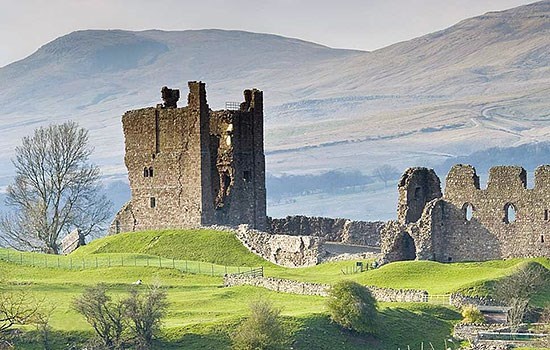History of Bayard's Cove Fort
Bayard’s Cove Fort was built in the early 16th century by the townspeople of Dartmouth to protect the town quay. The significance of its strategic position is best appreciated from the sea: it controls the narrowest point of the channel at the entrance to Dartmouth harbour.

The town of Dartmouth developed in the Middle Ages because of the value of the safe, deep water anchorage at the mouth of the Dart estuary.
It was here in the estuary that the English contingent assembled in 1147 and again in 1190 to depart on crusade. Originally, the major port on the River Dart was Totnes, higher upriver, but from the 13th century the name Dartmouth was being used for the harbour town that was gradually expanding south along the waterside.
The town became the main base for the wine trade with south-west France, and despite the loss of this source of wealth following the start of the Hundred Years’ War (1337–1453), Dartmouth continued to prosper with the growth of the cloth trade.
Building the fort
The fort may have been built as early as 1509–10 according to contemporary documents, and was certainly in existence by 1537, when it is mentioned as the ‘New Castle’ in a corporation lease. On the southern edge of the town, it stands at the end of a stone quay which was also constructed early in the 16th century.
Nearer the harbour mouth, Dartmouth Castle and its companion fort across the estuary, Kingswear Castle, had already been built in the late 15th century to guard the port.
Fearful of attack, the people of Dartmouth decided to built Bayard’s Cove Fort as a second line of defence, in case an enemy succeeded in evading the guns of Dartmouth and Kingswear.
Casting was one problem overcome in Henry VIII’s reign with improved iron manufacture; the rate at which cannon could be reloaded and fired also improved. The result was a new kind of castle like those at St Mawes and Pendennis in Cornwall (built 1540–45). Low and massive, they represent the climax of a process of development in which forts like Bayard’s Cove were an important intermediate stage.
DARTMOUTH UNDER FIRE
When Dartmouth eventually came under attack – during the English Civil War, more than a century after the fort had been built – the enemy came not, as expected, from the sea, but from the land. Dartmouth declared for Parliament but was captured in 1643 by a Royalist force under Prince Maurice, Charles I’s nephew, after a month’s siege.
The Royalists built new gun forts on the hilltops overlooking Dartmouth and Kingswear, but in 1646 they surrendered to the Parliamentarian New Model Army after a brisk assault under cover of darkness. A Parliamentarian recorded that ‘we became masters of the whole Town, and the old Castle [Bayard’s Cove] in which were 5 great Iron guns which commanded the River’.
THE FORT IN DECLINE
During the 18th century, Dartmouth went through a period of decline and the area around the fort became an overcrowded slum. Recovery began with the arrival of the Royal Naval College in 1863, and the growth of tourism.
Bayard’s Cove Fort was rescued from the state of neglect into which it had fallen and for a brief interval in 1940 was adapted as a machine gun post. It
was quickly abandoned for the same weakness that marked its construction: the restricted field of fire from the gunports. Since 1984 it has been in the care of English Heritage.
Bayard’s Cove Fort was never tested in a naval assault, but it rapidly became obsolete as the type of cannon for which it was designed was replaced by new and more powerful weaponry. Though the potential of artillery was recognised at an early stage, at the outset it was unreliable and often ineffective.
Description
The fort is irregular in plan but simple in design. It consists of a high, thick wall enclosing a roughly rectangular space with rounded corners, some 10 metres (33 feet) across. The original entrance was on the north side and survives as a much damaged pointed archway with a drip moulding above. Access to a narrow wall-walk was via a stone stairway climbing over the entrance arch.
The fort wall was originally topped by a parapet, mostly now missing, from which musketeers or archers could fire. The wall-walk gave access to a small area just west of the rock face where the gunners’ accommodation might have been sited: traces of lean-to buildings can be seen in the rock face here.
Below, a row of 11 gunports close to the water’s edge allowed heavy guns to be brought to bear on enemy ships. At this time, cannon were generally fixed to heavy wooden base-plates, rather than mounted on wheels.
The gunports are larger than those at Dartmouth Castle, which was the first English castle purpose-built with gunports to take heavy guns. They are similar in design, with internal splays and external slots for shutters.
Further Reading
Freeman, R, Dartmouth and Its Neighbours (Andover, 1990)
O'Neill, BHSt J, ‘Dartmouth Castle and other defences of Dartmouth Haven’, Archaeologia, 85 (1935), 129–57
Pattison, P, Dartmouth Castle (English Heritage guidebook, London, 2013) (buy the guidebook)
FIND OUT MORE



